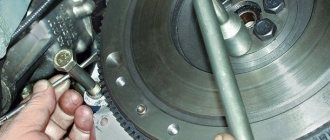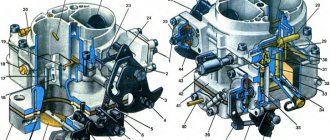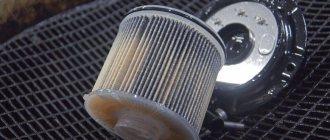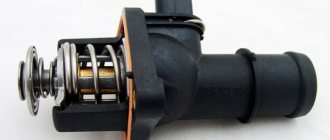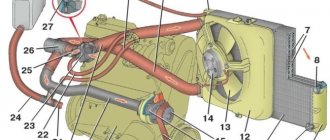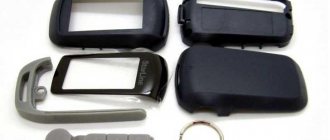Problems with starting arise not only for cars that have seen the world: owners of cars that have covered only a few thousand kilometers can also encounter difficulties with “hot” or “cold” starting of the engine. What is the cause of technical malfunctions in the first and second cases?
Outside the window - 22 °C. Should I warm up the engine before starting?..
Engine is bad: 5 possible reasons
- Poor quality gasoline or diesel fuel. The fuel may contain additives that are not suitable for a particular brand of car, or solid particles that cause filter clogging. In cold weather, diesel fuel can turn into a jelly-like form, which is difficult to pump.
- If the coolant temperature sensor malfunctions, the correct supply of fuel is disrupted.
- The mass air flow sensor has failed.
- The tightness of the fuel injectors is broken, for example, the sealing rings are damaged, which leads to gasoline leakage and an over-rich mixture.
- Failure of the fuel injection pump, for example due to wear of the bushings and drive shaft oil seal, is the main reason for difficult “hot” starting in diesel cars.
Sometimes the source of the problem lies in a clogged air filter or oxidation of the battery contacts. Replacing consumables or components does not always solve the problem - you should start with a comprehensive diagnosis.
The cause of poor starting of domestic cars when hot is often overheating of the fuel pump
If the problem of difficult starting affects a car on which there is a gas installation, the tightness of the hoses may have been damaged due to damage to the sealing elements due to high temperature. The leakage of the working environment could have occurred for another reason. Gas is not something to joke about - you need to consult a specialist.
Other reasons why a car won't start in cold weather
If the battery is in good condition and fully charged, it is possible that the car will not start in cold weather for the following reasons:
- Spark plugs are flooded;
- The starter is faulty;
- Engine oil is too thick;
- The ignition system is misregulated;
- The fuel supply is interrupted or the gasoline is of poor quality.
Timely prevention will help you not to worry about how to start your car in minus 30
The key to a calm winter for drivers is timely prevention. It is better to change the oil in mid-autumn, giving preference to types with an alphanumeric index 5w or 0w. Such oils will not thicken even at -30 degrees. Also, don’t forget to change your fuel, air and oil filters in the fall.
In addition, in order not to worry about how to start the car in minus 30, it would not hurt to check the level and density of the electrolyte, if necessary, change the washer and antifreeze, check the spark plugs, armored wires, tension of the generator and its charging.
Properly starting the engine in cold weather is a problem that car owners face when winter frosts arrive, especially if the temperature is significantly below -15 degrees, and the car has been parked outside all night. In such a situation, you need to follow several rules that can help you quickly start the engine and not ask for outside help or take public transport.
There are several main reasons that affect engine starting in cold weather:
- Malfunctions in the lubrication system.
- The ignition system is not working properly.
- Malfunctions in the fuel system.
- Weak battery charge.
Another reason is poor quality fuel in the car's tank. Most often, this is more relevant for diesel cars. There is no need to talk about the types of summer and winter diesel fuel here. Drivers of cars with a diesel engine are well aware that in winter they need to fill up with winter diesel fuel. Only the quality of this fuel is not the best; as a result, problems appear, paraffin is formed, which clogs the fuel filter.
Obstructed fuel supply to the engine creates malfunctions that prevent the engine from starting in winter. To remove paraffin and ensure engine starting in winter, it is recommended:
- Use special modern means to start engines.
- If the fuel tank is filled with summer fuel, and in the morning it is frozen, then the car needs to be hooked onto a tow rope and dragged to a warm garage.
- There is another method: take winter diesel fuel, pour it into a canister and heat it to 40 degrees. Next, pour it into the tank of the car. It should be remembered that the fuel filter also requires heating.
The whole truth about cold starts
Almost all drivers, if they don’t know for sure, then guess that starting the engine without preheating is harmful. That’s right: haste in this matter leads to rapid wear of rotating and rubbing components - pistons, cylinders, liners, crankshaft journals. The thickened oil does not immediately enter the mechanisms; the latter are left without lubrication and are forced to work “dry”. But it turns out it's not all bad news.
One cold start wears out the engine as much as driving 180-250 km
What to do with a diesel engine
To begin with, everything is the same as with a gasoline engine: warming up or recharging the battery. As an option that is applicable for any car: transportation to a warm garage. designed for low temperatures is the best prevention of the problem.
The old-fashioned method: pour boiling water over the fuel tank and... Alternatively, use a regular hair dryer.
How to start a car in cold weather.
With the onset of severe frosts, many motorists are faced with the problem of their car not starting.
We start the car, and instead of the usual rumbling of the engine, only the starter howls strainedly and that’s all - silence? The more attempts you make to start a frozen car, the faster the battery will discharge, and the car will soon completely stop showing signs of life.
How to start a car in severe frost?
Experienced drivers shared their experience and tips on how to do this, and what any car enthusiast should know if he drives a car in winter.
Firstly,
in very severe frosts, if possible, it is best to find a warm place for the car, preferably a garage, if not, then rent it.
Secondly
, put the car in warm-up mode.
Third
, if a car is a necessity in winter, then the fastest option is to revive the car, contact a service that provides car heating services - they will come, warm it up and start the engine.
Fourth
, you can ask drivers passing cars to “light a cigarette,” that is, to recharge the battery.
Fifth method
- this is trying to warm up the car yourself. Basically, a blowtorch is used for this, but in the most extreme cases. Such heating is unsafe; if you point an open fire at cold metal, the car can easily catch fire. Oil leaks may remain in the engine compartment of the car, which can flare up from the direct flame of a blowtorch. There are also all kinds of tubes and wires that can melt - they are not designed to withstand open flames.
Advice
– You need to warm up the car with a blowtorch if you know exactly how to do it. It is better if the open flame of the blowtorch is directed not at the metal of the car, but at the ground under the engine or along the protection casing. After carefully warming up the car for 15-20 minutes, you can easily start the engine.
How to start a car in cold weather?
To make it easier to drive a car in winter, experienced motorists advise preparing their “iron horse” for frost in advance.
1
.Fill the tank full with gasoline. Frost may cause condensation to form in the tank. The water sinks to the bottom of the tank. If you drive on a minimum level of gasoline, your car may “sip water”, and this can lead to costly repairs.
2
. Fill the windshield washer fluid only with the -30 marking. After filling, immediately wash the windows so that the anti-freeze agent can fill all the pipes.
3
. If the door lock is frozen, you can heat the lock key with a lighter or matches. The heated key will warm the lock cylinder and the doors will open, but it is best to spray a special icing agent into all the locks of the doors and trunk of the car.
4.
It is better to remove the battery and bring it home.
5.
Be sure to fill the gearbox and engine with winter oil. It is best if it is synthetic or semi-synthetic, because they are not very thick.
6.
Buy a special blanket and cover the engine under the hood with it.
7.
Fill the cooling system with good, high-quality antifreeze.
8.
In winter, a driver should always carry a cigarette lighter and a shovel in his car, and have a telephone number for rescue services with him.
And in conclusion: do not hesitate to ask for help from other drivers and try to help motorists who are in trouble yourself.
If you helped, they will help you too!
Theoretically, any gasoline engine is capable of starting in -30 frost, but only if it is in full working order. The ignition and fuel supply systems must function properly. Also, the engine must be filled with technical fluids that meet the climatic conditions. In addition, the vehicle must have a fully charged battery.
If you really have to start the engine in severe frost, then you need to listen to the advice of experienced motorists.
Ideally, the car should be kept warm, then there will be no problems with starting. But not all car owners have such a room.
If the car has to spend the night in severe frost, it is advisable to warm it up at least a couple of times, then in the morning the engine will start without problems. You can, of course, take the battery to a warm room overnight, but not everyone has this opportunity. In addition, this causes great inconvenience to the car owner.
Starting the engine “cold” can be difficult due to:
- a discharged battery that is unable to spin the starter and crankshaft flywheel (at sub-zero temperatures it discharges more strongly than usual);
- malfunctions of the fuel injection system;
- gaps between the cylinder and the piston, which appeared due to the narrowing of the sealing rings (if the tightness of the combustion chamber is broken);
- breakdowns of the starting nozzle, resulting in leaks;
- distributor cap defects, etc.
There is one more point - environmental. Fuel at low temperatures ignites less easily, so a “cold” engine requires a richer fuel mixture. This significantly increases the amount of harmful substances released into the atmosphere. By warming up your car for 10-15 minutes, you can make your own contribution to environmental protection.
There are actually many more reasons why the engine refuses to start. Sometimes replacing or cleaning the spark plugs, installing a new air, fuel or oil filter, or updating the O-rings helps. And sometimes you can get by with tidying up the throttle valve or other elements of the intake tract. Often it is not possible to independently determine the source of the problem, and is it worth it if a good service station can do it faster and better?
Don't drive the horses!
This point of the American article is especially highlighted. As we said a little higher, it is IMPOSSIBLE to give a load on a cold car.
Be careful with the gas pedal immediately after leaving. Your engine will need some time to warm up to operating temperature. Typically, it takes 5 to 15 minutes while the car is moving to reach the operating range. If you immediately press the gas pedal to the floor, nothing good will happen to the engine; it will experience serious loads, which, if they occur systematically, can lead to premature breakdowns.
Plus, fuel consumption will increase when the engine is warmed up and, overall, your car will operate at least 12% less efficiently in cold weather.
Therefore, do not try to customize a cold car. You will get nothing but increased fuel consumption and wear and tear.
Let us remind you once again that ALL ELEMENTS OF THE CAR NEED to be warmed up, so even if you warmed up the engine at idle as usual, almost to the ideal operating temperature, your speed for the first few kilometers along the road should ideally not exceed 40 km/h - 50 km/h. It is especially important to monitor the gearbox shifts to avoid its breakdown.
Problem 3 engine oil
If the wiring is in good condition, the battery is charged, but the car does not want to start, most likely the engine is frozen and the engine oil in it has thickened. Synthetic oil is best suited for winter, and cars filled with mineral oil or semi-synthetic oil are in the “risk zone” in cold weather.
To warm up the engine, some people use plastic bottles with boiling water, placing them under the hood of the car for a short time. In this case, the hood and engine compartment are covered with windproof material. Thanks to this, it is possible to warm the connecting rod-piston group and cylinder block, which are constrained due to thickened oil.
Some motorists, to revive the engine, use a blowtorch, or even start a fire under the crankcase. Both of these methods can be effective, but you need to remember that they are very dangerous.
The car is bad
The problem is less common, but if an already warmed up engine does not start well, this can become a big mystery for an inexperienced driver. Indeed, just now the machine was working like a clock, and suddenly, out of the blue, there was a problem.
In most cases, the engine does not start well when hot for two reasons:
- low fuel quality,
- malfunction of one or more sensors.
Poor quality fuel
If problems with starting the engine began after refueling, then with a 99.9% probability the reason is poor quality fuel. This statement is true for both gasoline and diesel engines. There are no ways to check the characteristics of fuel in artisanal conditions, so you will have to rely on indirect signs. It is often easier to drain low-quality fuel and refuel at a proven gas station. Otherwise, you will have to use various additives to bring the parameters of gasoline or diesel fuel to the desired values, but this is always a risk for the engine.
Electronic problems
If a VAZ of modern models does not start well, then the reasons may be in the electronics. However, foreign cars also suffer from this, but this mainly applies to used vehicles. Accurately diagnosing and eliminating malfunctions in the electronic components of a car is only possible with modern computer equipment.
Strictly prohibited
- Wash your car outside in frost below 20*C. Frozen drops of water will block not only door locks, but also internal mechanisms.
- Fill with gasoline of unknown quality. The engine may stall not from frost, but from impurities in the fuel.
- Use oil not intended for low temperatures.
- Never leave your car on the handbrake for a long time.
- Leave the car alone at night. The ideal option, of course, is to spend the night in the garage. But if you don’t have a garage yet or it’s difficult to get to it, and you will need the car early in the morning, park it in a group with other cars, or better yet, closer to bulky models such as a Gazelle or a jeep.
- Do not use the car for several days. Even if you don’t need to go anywhere on weekends, try to warm up your iron friend several times and at least ride around the yard. This way you won't let it freeze through. If a strong drop in temperature is expected, you may have to go out to warm it up at night.
Other reasons why a car won't start in cold weather
If the battery is in good condition and fully charged, it is possible that the car will not start in cold weather for the following reasons:
- Spark plugs are flooded;
- The starter is faulty;
- Engine oil is too thick;
- The ignition system is misregulated;
- The fuel supply is interrupted or the gasoline is of poor quality.
Timely prevention will help you not to worry about how to start your car in minus 30
The key to a calm winter for drivers is timely prevention. It is better to change the oil in mid-autumn, giving preference to types with an alphanumeric index 5w or 0w. Such oils will not thicken even at -30 degrees. Also, don’t forget to change your fuel, air and oil filters in the fall.
In addition, in order not to worry about how to start the car in minus 30, it would not hurt to check the level and density of the electrolyte, if necessary, change the washer and antifreeze, check the spark plugs, armored wires, tension of the generator and its charging.
How to start a car in cold weather.
With the onset of severe frosts, many motorists are faced with the problem of their car not starting.
We start the car, and instead of the usual rumbling of the engine, only the starter howls strainedly and that’s all - silence? The more attempts you make to start a frozen car, the faster the battery will discharge, and the car will soon completely stop showing signs of life.
How to start a car in severe frost?
Experienced drivers shared their experience and tips on how to do this, and what any car enthusiast should know if he drives a car in winter.
Firstly,
in very severe frosts, if possible, it is best to find a warm place for the car, preferably a garage, if not, then rent it.
Secondly
, put the car in warm-up mode.
Third
, if a car is a necessity in winter, then the fastest option is to revive the car, contact a service that provides car heating services - they will come, warm it up and start the engine.
Fourth
, you can ask drivers passing cars to “light a cigarette,” that is, to recharge the battery.
Fifth method
- this is trying to warm up the car yourself. Basically, a blowtorch is used for this, but in the most extreme cases. Such heating is unsafe; if you point an open fire at cold metal, the car can easily catch fire. Oil leaks may remain in the engine compartment of the car, which can flare up from the direct flame of a blowtorch. There are also all kinds of tubes and wires that can melt - they are not designed to withstand open flames.
Advice
– You need to warm up the car with a blowtorch if you know exactly how to do it. It is better if the open flame of the blowtorch is directed not at the metal of the car, but at the ground under the engine or along the protection casing. After carefully warming up the car for 15-20 minutes, you can easily start the engine.
How to start a car in cold weather?
To make it easier to drive a car in winter, experienced motorists advise preparing their “iron horse” for frost in advance.
1
.Fill the tank full with gasoline. Frost may cause condensation to form in the tank. The water sinks to the bottom of the tank. If you drive on a minimum level of gasoline, your car may “sip water”, and this can lead to costly repairs.
2
. Fill the windshield washer fluid only with the -30 marking. After filling, immediately wash the windows so that the anti-freeze agent can fill all the pipes.
3
. If the door lock is frozen, you can heat the lock key with a lighter or matches. The heated key will warm the lock cylinder and the doors will open, but it is best to spray a special icing agent into all the locks of the doors and trunk of the car.
4.
It is better to remove the battery and bring it home.
5.
Be sure to fill the gearbox and engine with winter oil. It is best if it is synthetic or semi-synthetic, because they are not very thick.
6.
Buy a special blanket and cover the engine under the hood with it.
7.
Fill the cooling system with good, high-quality antifreeze.
8.
In winter, a driver should always carry a cigarette lighter and a shovel in his car, and have a telephone number for rescue services with him.
And in conclusion: do not hesitate to ask for help from other drivers and try to help motorists who are in trouble yourself.
If you helped, they will help you too!


